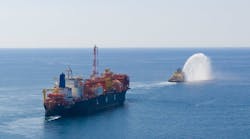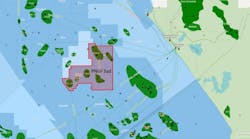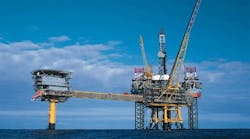Offshore staff
DUBAI, UAE -- RAK Petroleum has contracted Maritime Industrial Services (MIS) for engineering services on the Saleh field platforms off Ras Al Khaimah.
Saleh was brought into production in 1984, with five platforms installed and in service in the 1980s. Gas and condensate are exported through a 45-km (27.9-mi), 18-in. (45.7-cm) pipeline to the Rakgas processing facilities onshore Ras Al Khaimah.
Production tailed off rapidly after 1988. However, RAK became operator late last year, and announced plans to re-habilitate the facilities and redevelop the field, initially by deepening an existing well to the Thamama reservoir
MIS says it wikl provide engineering deliverables to support the requirements, and will finalize the scope for rehabilitation of four Saleh platforms in consultation with RAK Petroleum.
Last year, RAK chartered the high speed crew vesselTopaz Wave Piercer from Topaz Marine to ferry production personnel to and from its platforms offshore Oman. It is due to be delivered in April.
"The use of a fast, stable, and fuel-efficient crew vessel will significantly reduce our transportation operating costs and provide more safety for our crew as they commute from Ras Al Khaimah to our platforms in the Strait of Hormuz," said Michel Pick, group technical director of RAK Petroleum. "Working closely with Topaz for monthly servicing we will also minimize in-port down time."
The 24-m (78.7-ft) long vessel, according to RAK, brings several innovative features to the Gulf region. These include a stable wave-piercing catamaran hull design, claimed to provide a smoother ride in high sea states than comparable sized mono-hulled vessels. This improves comfort and stability of offshore crews (the vessel can take up to 40 at a time).
Topaz Wave Piercer also features twin Caterpillar engines combined with two Hamilton waterjet propulsion units. These power the vessel at speeds approaching 35 knots, sufficient to allow RAK to visit both the West Bukha and Bukha platforms in one day.
RAK also says theWave Piercer is more fuel efficient, with fuel consumption at 32 knots similar to what the company formerly achieved with a screw-driven vessel at 20 knots. Another plus is maneuverability: from full speed, the waterjet vessel can be turned around 180 degrees within its own length or be brought to a complete stop.
The bow design allows front on-platform disembarkation, with the vessel held securely into a V-notch style docking station. This allows the vessel to rise and fall with the sea swell, which is safer for passengers during transfer operations. RAK adds that the docking station provides more reliable platform evacuation in an emergency. s) when laden with cargo, passengers, and a 6.5-m (21.3-ft) container carrying emergency oil spill response equipment.
Safety features RAK has specified include bridge-controlled fire-fighting monitors, H2S sour gas sensors, a Dacon “man overboard” scoop, remotely operated searchlights; and a 360-degree bridge.
02/01/2011




